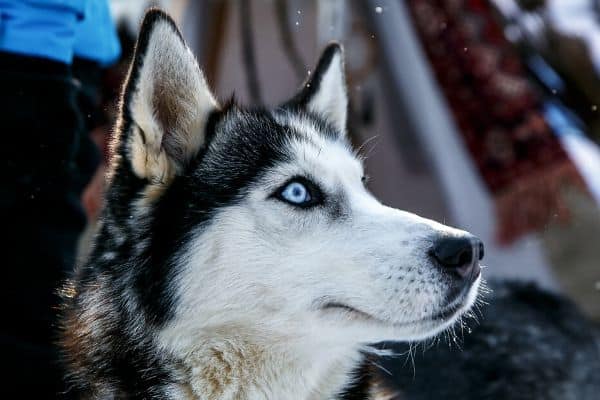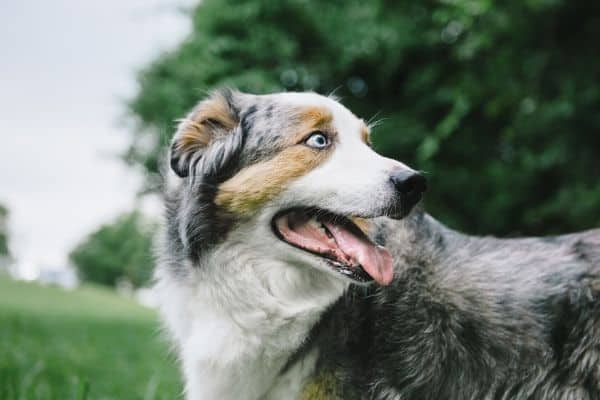If you’ve ever personally come across a dog with blue eyes, then you know firsthand how captivating and alluring the unusual color can be.
What is it about blue eyes that transfixes so many of us? Could it be the remarkable beauty that captures our attention, or is it the color’s rarity that draws us?
While the blue eye coloration is considered to be undesirable in many breeds, it nonetheless is sought out by many people wishing to own a unique pet.
How rare is it exactly? What causes it to occur? Which dog breeds often display the exquisite feature?
We’re going to cover all that and more. But first, let’s look at some dogs that regularly have blue eyes and those that have the potential for blue eyes.
5 Breeds Known for Having Blue Eyes
While the following lists are by no means comprehensive, they will serve to give you an idea of the wide variety of breeds that are capable of producing dogs with blue eyes.
Siberian Husky
When you picture a blue-eyed dog, chances are the beautiful Siberian Husky comes to mind and with good reason.
An estimated two out five Siberian Huskies will have blue eyes, and an estimated 15% will have one blue eye and one brown one.
Siberian Husky mixes, such as the adorable Pomsky (a cross of a Pomeranian and Husky – learn more on our Pomsky page), may inherit blue eyes as well.
Siberian Huskies are affectionate but have a reputation for being rather mischievous.
They are friendly with people and other dogs, though they do have a strong prey drive and may not hesitate to chase small animals.
You’ll definitely want to use a strong leash and a secure collar, or even better, a sturdy harness when walking your Husky. (We list the best of the best in this article.)
Australian Shepherd
The Australian Shepherd, as the name implies, is a herding dog, though the Australian part of the name is a misnomer.
They actually got their start in the Pyrenees Mountains of Europe. Collies and Border Collies (both hailing from Scotland) were added to the lines before the breed made its way to California.
Blue eyes commonly crop up in merle pattern dogs and add to the charm of this hard-working, agile, super energetic breed.
Mixes, such as the ever-popular Aussiedoodle may have stunning blue eyes too and tend to shed significantly less than full-blooded Australian Shepherds.
Because of the seemingly boundless energy of Australian Shepherds (and mixes), plenty of exercise on a daily basis will be needed.
Games of fetch with heavy, hollow rubber toys, like this one, that will bounce unpredictably and can be thrown much farther will do a better job of burning up these dogs’ energy than a regular tennis will.
Dalmatian

One of the most recognized breeds of all time, the Dalmatian was originally used to guard horses and carriages.
Dignified in both appearance and personality, this breed can be slightly aloof with strangers but is perfectly comfortable at home with his family.
Stunning blue eyes are common with this breed.
Unfortunately, beautiful blue eyes are not the only trait common to this breed. Nearly one-third of all purebred Dalmatians suffer from some degree of hearing loss.
The defect is related to the lack of melanin-producing cells (melanocytes) within the ear, and those with small, broadly scattered spots (the “ideal” Dalmatian markings) and blue eyes are associated with the highest incidences of deafness.
[mv_video doNotAutoplayNorOptimizePlacement=”false” doNotOptimizePlacement=”false” jsonLd=”true” key=”wogi3umaj3lvntlyejmo” ratio=”16:9″ thumbnail=”https://mediavine-res.cloudinary.com/v1607128379/byymmbusfmaefyccrudj.jpg” title=”Our Most Popular Articles” volume=”70″]
Border Collie

Famous for their nimble, stealthy movements and intense focus when doing what they were born to do, that is herd sheep, Border Collies are a wonder to watch in action.
Their unsurpassed intelligence, trainability, and athleticism make them champions at not only herding but also agility, flyball, obedience, and flying disk competitions.
Due to their energy levels, owners sometimes have a hard time keeping up with them and wearing them out.
Toys that make your dog do most of the work and allow you to just enjoy watching the action, like this ball launcher, are ideal for highly active, intelligent breeds like this one.
Breed standards for the Border Collie allow for any eye color, coat colors and markings, so it’s no surprise when blue eyes appear fairly regularly within the breed.
Catahoula Leopard Dog

Along with spicy, rich gumbo, one of Louisiana’s many claims to fame is the Catahoula Leopard Dog.
This breed is noted for its unique method of herding. Working as a team, these dogs create a living fence around a herd to hold it in place for their master.
Eyes in varying shades of blue routinely appear in these working dogs.
Dog Breeds That Sometimes Produce Blue-Eyed Dogs
Cocker Spaniel
Both American and English Cocker Spaniels sporting the merle pattern can have blue eyes.
Though the American Kennel Club (AKC) doesn’t yet recognize merle or blue eyes as acceptable in either breed, it is nonetheless a popular trait and in high demand.
The Cocker Spaniel is an old breed that developed as an offshoot of the Spaniel-type dogs who were used for hunting as far back as the 1300s.
Often described as cheerful and merry, today’s Cocker Spaniels are playful and devoted, though they can be somewhat sensitive or timid when not properly socialized.
These smart, affectionate dogs are as excellent in the role of family companion as they are in the field working alongside a hunter.
Alaskan Klee Kai
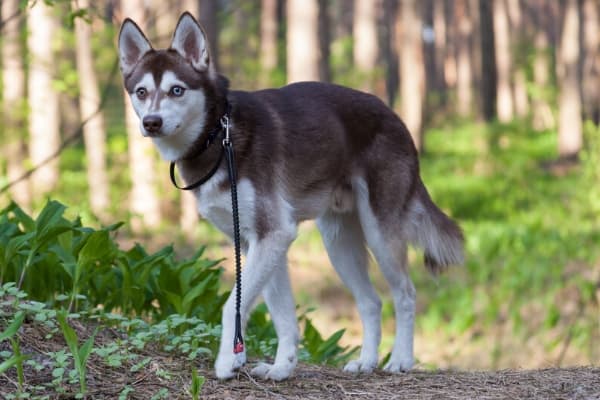
A relatively new breed, one not yet recognized by the AKC, is the Alaskan Klee Kai.
These dogs are similar in appearance to the Alaskan Husky and the Siberian Husky as both these breeds were used as foundation stock, but these little guys only weigh between 10 – 20 pounds.
One or both eyes are often blue, though brown, amber, green, and hazel appear frequently as well.
This breed is fast and nimble, and once trained, can zip through an agility course with impressive speed and accuracy.
Training and socialization is critical as these dogs tend to be very wary of strangers.
Beagle
According to the AKC, Beagles have been America’s most popular hound dog for years.
Their cheerful, loving temperament and adorable faces are hard to resist. One sporting rare blue eyes is a treasure indeed.
Celebrated for a superb ability to hunt rabbits and foxes, Beagles are still valued today for their tracking skills and range of vocalization including the standard bark, howl, and the infamous baying.
Their sense of smell is so acute that the United States Department of Agriculture employs a team of Beagles, known as the Beagle Brigade, to detect prohibited agricultural products being smuggled into international airports.
Old English Sheepdog
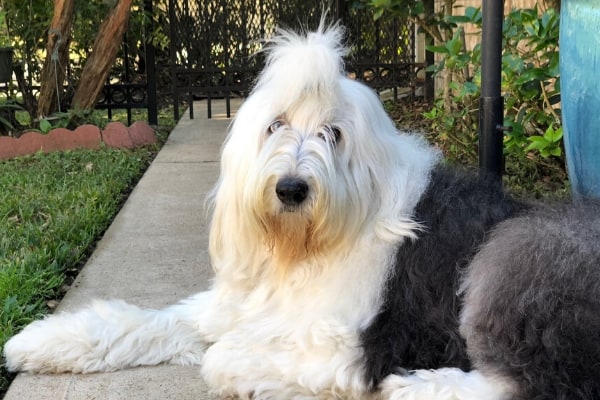
The Old English Sheepdog is one of a few breeds who the AKC doesn’t fault for having blue eyes or one blue and one brown eye.
Unlike the name suggests, these dogs were once used primarily to herd cattle, not sheep. Ironically, their long shaggy coats were occasionally shorn to be woven into yarn for clothing.
These shaggy dogs are known for being patient with and protective of their family, particularly children.
Don’t be fooled by their ambling gate, as these dogs will need lots of daily exercise and playtime.
In fact, they can often be found at agility, obedience, and rally trials working off some of their energy and putting their smarts to good use.
That shaggy coat does require regular maintenance though to keep it tangle free and flowing gracefully.
For coats like this, special grooming equipment, like this highly recommended deshedding tool from Amazon, is essential for removing loose hair and preventing mats from forming close to the skin.
Great Dane

For their massive size and weight, Great Danes are surprisingly friendly with an eager-to-please, easy-going temperament.
That’s fortunate for owners as males can tip the scales at 175 pounds and stand 32 inches tall at the withers.
These gentle giants are available in many colors and patterns, and the AKC allows for blue eyes on harlequin and merle patterned dogs.
Pembroke and Cardigan Welsh Corgi

The Pembroke Welsh Corgi is considered to be a separate breed from the Cardigans, though up until the late 1800s, they were often interbred.
The key differences between the two breeds is the ear shape which is pointed in Pembrokes but rounded in Cardigans and the length of the tail which is much longer in Cardigan dogs.
Blue eyes appear in both Welsh Corgi breeds but are only considered acceptable by the AKC on blue merle Cardigans.
What these breeds lack in stature (they are only about 10 -12 inches tall at the withers) is made up for in personality.
They are both affectionate and friendly with an all-around agreeable temperament.
Shetland Sheepdog

Similar in appearance to Collies, though much smaller, Shetland Sheepdogs excel in numerous dog sports including agility and herding trials.
The AKC recognizes only three colors – black, blue merle, and sable, each with white or tan markings allowed and permits blue eyes in dogs with a blue merle coat.
Shelties take to training quite well due to their impressive intelligence and obedient nature.
Despite their small size, these alert dogs are often used as watchdogs (not guard dogs as they are too small to be be menacing) because of their eagerness to bark at the first sign of trouble and their innate mistrust of strangers.
Great Pyrenees
Beautifully majestic in appearance and calmly patient by nature, the snowy white Great Pyrenees has been revered for centuries.
Once used to guard flocks and deter predators (both four-legged and two-legged thieves), this breed is famous for its incredible strength, courage, and mellow personality.
Blue eyes fall outside of the acceptable breed standard but do occur and are absolutely gorgeous against the lush, white coat.
American Pit Bull Terrier

Despite their undeserved reputation, American Pit Bull Terriers are incredibly good-natured dogs.
They were actually once considered to be the All-American dog and were featured in many advertisements during World Wars I and II.
Blue eyes do occasionally appear in this breed, especially in dogs with a blue coat and nose and those with merle patterning.
(Blue Nose Pit Bulls are rather rare but are undeniably gorgeous. Take a look for yourself and discover 20 surprising facts in this article.)
Although they can be serious chewers, they aren’t aggressive by nature, and some sturdy chew toys will satisfy their strong jaws.
We researched the best toys for Pits and found these indestructible chew toys to be outstanding.
Even though American Pit Bull Terriers aren’t recognized as an official breed by the AKC, the United Kennel Club (UKC) does recognize them and was in fact founded as a way to register these intelligent, gentle dogs.
Boxer
Boxers were so named because of their tendency to utilize their front feet during play or when defending themselves much as a human boxer does.
Blue eyes have shown up in fawn, brindle, and white (not an acceptable color for the show ring) dogs due to a recessive gene.
Boxers are known for being loyal, intelligent, brave, playful, and exceptionally good with children, but proper socialization as puppies shouldn’t be neglected.
Australian Cattle Dog
Australian Cattle Dogs were created by carefully breeding Smithfield dogs (now considered to be extinct) with wild Australian Dingoes, Collies, and Dalmatians in an attempt to produce the perfect herding dog.
Puppies are born with a white coat that turns blue-gray or red over time. While the breed standard calls for dark brown eyes, dogs with blue eyes do show up now and then.
These highly intelligent dogs are intensely energetic and thrive when routinely challenged both physically and mentally.
Weimaraner
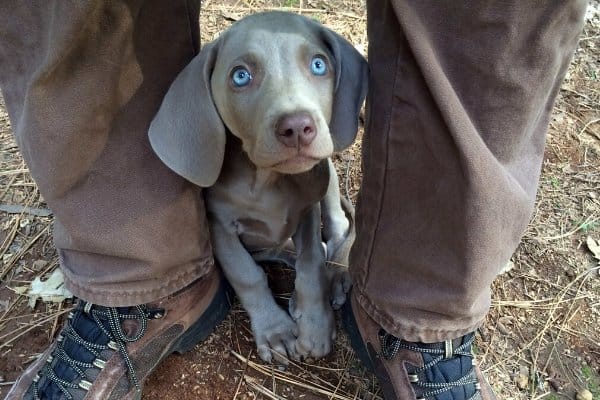
Often mistaken for a Labrador or a Vizsla, the gorgeous Weimaraner was developed in Germany in the early 1800s as first a big-game hunter and later as a pointer and retriever of gamebirds.
When blue eye coloration does occur, it is most often a bluish-gray, not a deep blue.
The Weimaraner is frequently referred to by his nickname, the Gray Ghost due to his silver-gray coat coloration and his tendency to always be alongside his owner.
This devoted breed is known for its high exercise requirements and sweet dispositions – unless you are a small, furry creature, in which case you might be in trouble.
Basset Hound
Originally bred in France and Belgium for a superior tracking ability when hunting, the mournful-looking Basset Hound today ranks as the AKC’s 39th most popular dog.
A Basset Hound’s short little legs are packed with power and are built for endurance.
These dogs are not as lazy as they might appear, though a touch of stubbornness is common to the breed.
In merle patterned dogs, blue eyes sometimes occur though it is considered a major fault in the show ring.
Mastiff

According to his journal, Julius Caesar was greatly impressed with the mighty Mastiffs after encountering them in an invasion of Britain in 55 B.C.
They are still a force to be reckoned with today due to their large (up to 230 pounds) size and formidable appearance.
Mastiffs and other related Mastiff breeds such as the Bull Mastiff, Neapolitan Mastiff, and Tibetan Mastiff sometimes produce pups with striking blue eye color.
Shih Tzu

The name Shih Tzu translates to mean lion dog. That’s a big name for such a little dog to carry, but they seem to manage just fine.
Believed to be at least one thousand years old, this elegant breed originated in China as pampered royal lap warmers in emperor’s palaces.
The coat comes in many colors, and blue-coated dogs, though rare, often come with blue eyes.
American Staffordshire Terrier

American Staffordshire Terriers (Amstaffs for short) are descended from Old English Bulldogs who were mixed with Terriers to increase their adeptness at rat baiting.
They are loyal, athletic, confident, and very tolerant with children, making them ideal candidates for family pets.
Amstaffs come in a wide variety of colors, coat patterns and eye pigmentation.
Eyes are often seen in shades of brown, amber, hazel, green, and blue, though nothing quite adds an aura of mystique to this muscular but affectionate dog like a lovely pair of baby blues.
Rottweiler
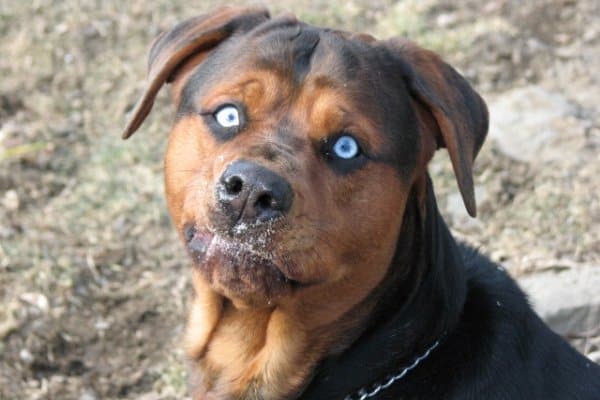
While not very common, some Rottweilers are born with either two blue eyes or one blue eye and one brown eye, a condition called heterochromia.
These strong, muscular dogs have a well-deserved reputation for being excellent guard dogs though when raised and socialized properly, they make fantastic companions as well.
Rottweilers have been used extensively in both police and military work and, due to their high intelligence and trainability, have been known to excel as therapy dogs, search and rescue dogs, and guide dogs.
Bergamasco Sheepdog

Once used to guide and protect sheep in the Italian Alps region, Bergamasco Sheepdogs are known for their one-of-a-kind coat consisting of long, matted, felted hair called flocks.
Though the AKC counts blue eyes as a disqualification in this breed (though merle color patterns are allowed), they nonetheless can and do occur.
This breed is highly intelligent with a peaceful, balanced personality.
They are strong and brave and will naturally watch over their family much as they once did with their flocks of sheep.
Their slight tendency to be independent is nicely offset by their gentle and affectionate nature.
What Does it Mean if a Dog has Blue Eyes?
Without delving too deeply into the vast and confusing world of genetics, let’s take a brief look at the four main reasons dogs are born with blue eyes as opposed to the usual brown.
Merle Gene
The merle gene is responsible for creating mottled or dappled patches of color in the coat and on the skin by diluting random sections to a lighter color.
Pretty blue eyes are a side effect of the dominant merle gene, though not every merle dog will display blue eye coloration.
The blue eye color is caused by the suppression, or dilution, of pigmentation within the iris.
The greater the amount of color dilution over a dog’s body, the greater the chances are that a pup will have blue eyes.
While merle patterned canines typically are as healthy as their solid-colored counterparts, dogs referred to as double, or homozygous, merles are a different story.
When two merle dogs are bred, the resulting litter will inherit the dominant merle gene from both parents, hence the term double merle.
Double merles often suffer from blindness, deafness, skin cancer, and extreme sun sensitivity because of the lack of pigmentation in vital areas.
It is considered unfair and cruel to intentionally breed two merle dogs that will result in a litter with multiple, major health problems.
Blue Eye Gene
A few dog breeds such as the Siberian Husky and the Border Collie have a dominant blue eye gene that is independent of coat color.
Dogs inheriting this gene will have blue eyes (or just one blue eye – a condition called wall eye) ranging from a light, nearly white-blue to a deep sky blue.
The nose and coat color are unaffected by this gene.
Many breeds such as the Pembroke Welsh Corgi and the Beagle have a recessive blue eye gene that, though present, doesn’t appear nearly as often as the dominant version.
Lack of Pigmentation Around the Eyes
Canines born with large patches of white on the facial area, particularly around the eyes, will often have blue eyes as a result of the distinct lack of pigmentation in that region.
In predominately white dogs, this is the most common reason for the occurrence of blue eyes.
Note that blue-eyed dogs resulting from a lack of facial pigmentation are not albinos. They are capable of producing melanin while albinos are not.
Albinism
True albinos are quite rare and are characterized by the complete lack of melanin (color-producing pigment) and the enzymes that produce it.
Though pure albinos can only be positively confirmed by genetic testing, a close visual inspection will reveal an absence of pigmentation throughout the entire body resulting in a coat that appears white but actually has no color at all.
The skin, nose, eyelids, irises, and tissue around the eyes will appear to be very light pink. That pink is actually the result of a lack of color and only appears pink due to the blood flow beneath the skin.
So, what does all this have to do with being blue-eyed?
While it’s true that complete albinos are quite rare, incomplete albinism is slightly more common.
A dog born with the ability to produce even the smallest amount of melanin are not true albinos.
While they’ll often have albino characteristics, such as pink noses and massive areas lacking pigmentation, they often have light blue eyes.
Can Any Breed of Dog Have Blue Eyes?
Because of the many different genes and their associated mutations and variations, diverse additions to lines that took place many years ago, and the recessive blue eye gene, most dog breeds are theoretically capable of producing offspring with blue eyes though in many breeds it’s a rare event.
Are Blue Eyed Dogs More Prone to Health Issues?
Many wonder if blue eyes in a dog are bad. The only real health issue associated with a blue eyed dog is an increased sensitivity to bright light and sunlight.
Those captivating blue eyes have a lower concentration of melanin in the irises than darker eyes do. Without the protection that higher concentrations of melanin provide, more light is permitted to pass through to the retina resulting in squinting and discomfort.
The vast majority of health concerns associated with blue eyes are centered on double merle dogs. Double merles frequently are born with eye deformities which lead to blindness.
Often, they lack necessary pigmentation in the inner ear which causes certain sensory nerve cells to die. The result is deafness in one or both ears.
Double merles are also much more likely to develop skin cancer on the nose and areas of the body that are not protected by pigmentation.
Disorders That Can Cause The Eyes to Turn Blue
While all puppies have blue eyes at birth, between the ages of 4 – 16 weeks, most pups’ eyes will undergo a change in color, gradually turning brown, hazel, or green over time depending on the amount of melanin produced.
Sometimes the eyes do indeed remain blue throughout the dog’s lifetime. For dogs in this category, the blue coloring will be bright and clear.
A dog who begins to develop a blue hue or cloudy appearance as an adult is not spontaneously changing eye color.
Rather, they’re experiencing one of several eye disorders.
It’s best to consult with your veterinarian any time a distinct change in the eye is noticed so a treatment plan can be enacted right away.
Common causes of an older dog developing a bluish tint in one or both eyes include:
- Cataracts.
- Nuclear sclerosis.
- Glaucoma.
- Stromal corneal dystrophy.
- Anterior uveitis.
- Hepatitis blue eye.


